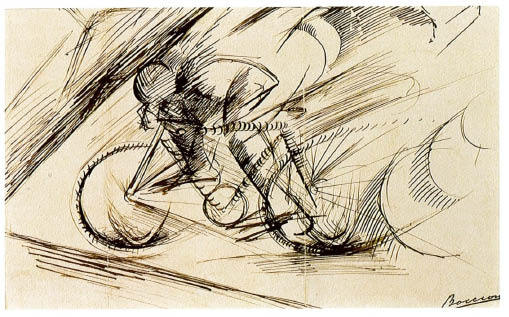On the Move: Visualising Action
Estorick Collection, 39a Canonbury Square, London N1, until 18 April
The Estorick Collection, which specialises in modern Italian art, has mounted a series of rewarding exhibitions in recent years, all of which bear some essential relationship to its permanent holdings. Futurism remains the best known and most widely celebrated modern Italian art movement, and the current exhibition helps to put in context the Futurist obsession with recording movement through the static image. This display, curated by Jonathan Miller, offers a background to and explanation for the way in which the Futurists depicted movement by examining how animal locomotion was first represented and analysed through the developments in scientific photography.
It is essentially a photographic exhibition, and the two big stars of the show (and the accompanying catalogue, price £12.95) are Eadweard Muybridge and Etienne-Jules Marey. Muybridge is familiar to art-lovers for the crucial inspiration he provided Francis Bacon, while the more scientific Marey is rather less known. The visitor to the exhibition is greeted in gallery one by a bronze flight of seagulls merging into each other. This dramatic and beautiful sculpture is by Marey, and is the culmination of his research into how birds actually fly. This ‘endless column’ of birds is like a spine with many wings, showing all the positions of flight from the nearly closed (wings underneath the body), to the full span at the sides, to the archetypal V arching over their backs. This sculpture is juxtaposed with John Wootton’s 18th-century painting ‘A Race on the Round Course at Newmarket’, in which the steeds are depicted in classic ‘rocking-horse’ stance, with front and back legs extended. Thus are the scientific approach (based on direct observation) and the artistic (based, in this case, on assumption) tellingly contrasted. It was to cure art and society in general of such misunderstandings that Muybridge was first commissioned to record animal locomotion accurately in photos.
Sheets of Muybridge’s photographic studies (collotype prints from c.1887) hang in this gallery, first of male and female humans, then of vultures and cockatoos. Next to them are platinum prints by Idris Khan (born 1978), inspired by Muybridge, but featuring superimposed shots of figures rising. Shot is an operative word here: in one of the display cases is Marey’s photographic rifle, an early attempt to trace the changes of rapid movement. A handful of linocuts from the artists of the Grosvenor School follows, particularly fine being Cyril Power’s ‘The Giant Racer’. Then comes the Estorick’s own Balla painting, ‘The Hand of the Violinist’. It has never made such sense as it does in this context.
There’s a wonderfully eccentric photo of Marey’s collaborator Georges Demeny in a black suit with white lines and points on it, invented in another attempt to track movement, through geometrical chronophotography. The lines and dots create a beguiling effect but too inexactly for the scientific mind. As Marey’s experiments grew more successful, he returned to the flight of birds and produced a series of action photographs of herons and ducks, and finally a seagull seen from above. This last looks like the leaves of a fern radiating from a central stem and led to the bronze sculpture mentioned earlier. A multiple exposure taken in 1952 by Eliot Elisofon of Marcel Duchamp walking downstairs (a witty reference to his ‘Nude Descending a Staircase’, 1912) demonstrates the later development of such imagery.
In gallery two are more photos of human movement, this time by Thomas Eakins. A solid resin sculpture by Geoffrey Mann evokes the flight of a pigeon in lovely white waves like stylised folds of drapery. Nearby is Bertelli’s famous ‘Continuous Profile (Head of Mussolini)’ from the Imperial War Museum. Eakins is followed by a professor of electrical engineering at Massachusetts Institute of Technology, Harold Edgerton (1903–90), whose experiments in stroboscopic photography resulted in such exquisite studies of frozen movement as ‘Foil Salute’ (1938), the blade whipping through the air, and ‘Densmure Shute Bends the Shaft’, giving the player a resplendent spiral halo of golf clubs. Gjon Mili captures the bowing of violinist Jascha Heifetz, Aaron Siskind the ‘Pleasures and Terrors of Levitation’. Upstairs in a third gallery are optical toys such as Muybridge’s zoopraxiscope discs, early flicker books and magic lanterns — the Kinora and the Zoetrope. It’s a fascinating display, even if the human race is still dancing in the dark in spite of all its scientific discoveries and technological advances.
In the West End, a pair of shows have just opened at Messum’s: The Elemental North (at 8 Cork Street, W1), which features a group of modern and contemporary artists working in the north of England, and Len Tabner: from South Gare to Ravenscar (at 28 Cork Street). Tabner is one of our most intriguing Romantic landscape painters, engaging with both the sublime and with Abstract Expressionism, painting vast works on paper anchored to his Land Rover in the teeth of the storm. He conjures the subtlest effects in colours and textures that don’t always photograph well and have to be experienced first-hand. I admit to being partial — I contributed an essay to the catalogue — but these splendid evocations of place and weather demand an impassioned response. Meanwhile, The Elemental North, in the gallery opposite, also features Tabner along with Peter Brook, Sheila Fell, Peter Sarginson and Lilian Colbourn. But the real discovery of the show for me is Percy Kelly (1918–93), whose powerful charcoal drawings of roads vanishing into the landscape have an essential and compelling magic. Both shows continue until 6 February.






Comments